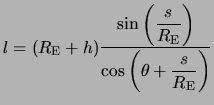![\includegraphics[]{figures/elveLocate.eps}](img361.png) |
![\includegraphics[]{figures/elveLocate.eps}](img361.png) |
The time-resolved optical features of elves as measured in the Fly's Eye not
only discriminate elves from other flashes, but also provide
quantitative information regarding the location of each elve with
respect to its causative CG lightning stroke.
The field-of-view of each Fly's Eye photometer was measured precisely
(Figure 3.11 on page ![]() ), and the pointing elevation and azimuth at any
time during observations were recorded by an electronic clinometer and
a compass-adjusted, graduated mount. This knowledge, coupled with the
lightning locations given by the NLDN
and the delay in each photometer between the sferic and the flash
onset, constrain in three dimensions the source of the first light
seen in each photometer [Inan et al., 1997].
), and the pointing elevation and azimuth at any
time during observations were recorded by an electronic clinometer and
a compass-adjusted, graduated mount. This knowledge, coupled with the
lightning locations given by the NLDN
and the delay in each photometer between the sferic and the flash
onset, constrain in three dimensions the source of the first light
seen in each photometer [Inan et al., 1997].
Figure 4.1 shows how this is possible for the case of a
photometer pointed directly over the causative CG. The VLF radio
pulse from the CG return stroke constitutes a ground wave
propagating at very nearly the speed of light (![]() ). It reaches
points on the surface of the Earth a time
). It reaches
points on the surface of the Earth a time ![]()
![]()
![]() after the
return stroke occurs; here,
after the
return stroke occurs; here, ![]() is the great circle path length from
the lightning location.
is the great circle path length from
the lightning location.
The onset of an optical flash in a photometer which is colocated
with the VLF receiver is due to a VLF pulse propagating to an
ionospheric point, and the resulting optical wavelengths
propagating from that point to the photometer, both at the speed of
light. The segment length ![]() between a point near the ground
(observer or lightning) and one in the ionosphere for a spherical
Earth is
between a point near the ground
(observer or lightning) and one in the ionosphere for a spherical
Earth is

The onset delays in each photometer for all the events ranged from 97
![]() s to 620
s to 620 ![]() s, where the longer times correspond to parts of
the elves located behind the source lightning or far to the side of
it. However, the first appearance of each event in any photometer
occurred almost exclusively between 100
s, where the longer times correspond to parts of
the elves located behind the source lightning or far to the side of
it. However, the first appearance of each event in any photometer
occurred almost exclusively between 100 ![]() s and 200
s and 200 ![]() s after
reception of the associated sferic.
s after
reception of the associated sferic.
Figure 4.13 shows a top-down view of source locations determined in this way for a bright flash. The uncertainty due to the extent of the fields-of-view is shown by the dotted quadrilaterals. We performed this analysis for all identified elves associated with an NLDN flash, and in a majority of cases, flashes were localized at a distance of over 100 to 200 km from the source lightning. In several cases this distance was well over 300 km, as predicted for strong discharges [Inan et al., 1997].
While both the altitude and the geographic location of the initial
observed point of each flash are determined in this way, the altitude
is not as tightly constrained for very low elevation angles (about
4![]() on the 27th of August). Nevertheless, the deduced lower
altitudes of each flash source remained roughly consistent with the
predicted 85-95 km [Inan et al., 1996c] and served as a sanity
check for the discrimination of elves from Rayleigh-scattered light,
which, due to its short onset delay, would have a deduced altitude
near zero (see page
on the 27th of August). Nevertheless, the deduced lower
altitudes of each flash source remained roughly consistent with the
predicted 85-95 km [Inan et al., 1996c] and served as a sanity
check for the discrimination of elves from Rayleigh-scattered light,
which, due to its short onset delay, would have a deduced altitude
near zero (see page ![]() ).
).